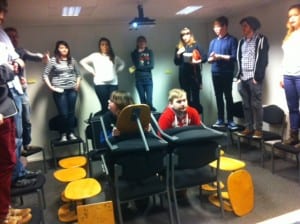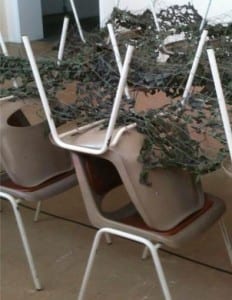When I first saw the grandstand many weeks ago, I was intrigued and just saw it as the place at the end of Carholme road, a building in limbo but yet a significant place that is present as you enter Lincoln. Thousands of people pass it every week including myself, without even a thought of what this great building has been through. I feel that our site performance as a whole gave friends, colleagues and the public an opportunity to see a variety of performances that linked to the grandstands past, present and future. The moment each person enters, the building it takes a part of them, it takes their initial thoughts, feelings similar to what we were ask to do on our first visit to the site. Hopefully after our performance, they leave their mark not only with the building but in their own memory and thoughts. No matter your age, background whether you’re a local or a visitor it is a place of safe heaven, a place to go to see and talk to people, to practice in a band, to give blood, to feel part of a community. All of this happening in the 21st century makes me curious as to who out of all the people who grace the grandstand for one reason or another know of Lincoln and the Grandstand’s past. It has been lost in the walls but hopefully us bringing in some performance involving its history, observations and future may have given it some life, and hopefully communicated to the community how important and useful it can be for Lincoln’s future.
1st May 2013: Performance Day
The day was finally upon us, like a tank into battle, we as a group were to build the tank for the last time. I thought everything would run smooth, but like the testers of the tank found out, it’s not all smooth running. Due to a sudden illness we had to make altercations to our first showing at 1o’clock and minor adjustments to the 3’oclock showing. This didn’t hinder the structure of our section, the only change came when we had to make an executive decision and adapt to building the tanks caterpillar tracks by reducing the 4 people down to just two people, myself and Ben. We would single handily build move the caterpillar tracks towards the audience. Even though it wasn’t as quick as it was with all 4 of us, I found it worked well, as it left Callum and Steph free to guide and keep the audience in the marked box.
Our Tank performance linked nicely with Greg and Jordan’s pieces in which we worked on a rotational basis. This was a good idea as it gave the audience chance to experience all three performances in more intimate groups. However in practice at 1 o’clock the rotation did come with some difficultly, as there was a mix up with where one group went but this was quickly resolved and the Tank was only built twice instead of three times. The logistics of the rotation was reworked and ran smoothly in the performance at 3’oclock.
As a group we also found there was a difficulty in repeating our performance consultatively for three different audiences. It was inevitable that each audience member or group would see exactly the same as the last. This was due to the nature of the performance and working with unreliable objects (chairs) and not having a fixed audience number. But I do believe that this did in a way work nicely as it gave us chance to build our confidence and rework any bits to tailor our audience.
A key aspect to our whole process was the building of the tank; this was both a creative idea to use chairs but our worst enemy when it came to placing them on top of each other. Out of the five times we performed our section in both practice and performance only 1 chair fell. This didn’t hinder our performance as we had practice what to do if the unavoidable happened. The odds were stacked in the chance of a chair falling but it only made us carry on and gave us a chance to adapt to the surroundings. Similar to how the tank evolved, it had to adapt and if it didn’t work they would retract, rebuild and make do, mend and push on. Personally, I found the chairs were tricky, I peculiarly struggled the most balancing one chair on top of the other, this I think hindered my performance a little because I was too busy concentrating on the chairs not falling that I almost forgot about the words in the first performance, but toward the last time it almost became a routine and ran smoothly.
‘From the Blood, Through the Mud, To the Green Fields beyond’
These words added atmosphere to our piece, both said at the beginning and the end of the piece. The words chanted as the chairs were moved added a sense of tank creation to the audience and I think it worked well. As we started to reach the last chair you could hear the exhaustion through our voices of performing the tough repetitive movement with the chairs and the chant at the same time. Although I was a little slower than Ben, I think the pace kept the audience intrigued and interested into what was happening around them.
The number of audience members that experienced the Tank varied through our day, from 2 to est.15 people. This made a difference to the beginning of our piece, as we wanted to make the audience feel as though they would in a real Tank, claustrophobic. Putting the piece of army netting of the top of them, added some more discomfort however this was difficult only have 2 audience members but we adapted and in some cases instead of holding the netting up high, we lowered the netting so they had to crouch down. With the performance however, we all felt the pace of the piece could have done with being smoother and a little more movement. Personally, I think we should have done something more exciting or have more panic in our voices between the transactions.
The section in the middle of our piece I felt was the strongest was the diary extracts. Although we were shaky on lines, the way in which we delivered the lines, towards the audience and overlapping showed panic, and as we layered up our voices and repeated our extracts over and over again the audience were surrounded by different voices at different paces and tones which also could be seen as us making them feel more claustrophobic. They were also hearing the thoughts of real people and either their panic, and their feelings as the Tank would advance into battle of which I would hope left an impression on the audience members as they watched our last sequence.
‘LT. Arthur E. Arnold, D Company, Heavy Section MGC:
We were advancing; the tank was on top of the trench. There we paused, whilst the thickest guns raked the enemy to port and starboard, then on we went again. ((http://www.youtube.com/watch?v=8Y0ZHESxVEc ))
Another aspect of my contribution to the overall performance ‘Safe Bet’ was music. Although I had preconceptions at the beginning about playing my Tenor Horn in public after not playing for months, I am really glad I did it. It gave me the chance to showcase something which not many people knew I could do, and let me have the opportunity to gain confidence in playing again. In performance I worked closely with Jordan to get the timings right with his poem, and on some occasions as he said ‘as the band played the last post’, the main melody of the last post would juxtapose the words being said. The music also worked well with the poem, as he talked about the fallen, and the last post was written to remember the soldiers who have lost their lives in the numerous wars from WW1 to present. It is a timeless song, which related to every audience remember. I enjoyed hearing the brass sound hitting the walls of the now bare weighing room, and how it linked in to Jordan’s speech, the factor that I fluffed a few notes only added to the performance, and I would like to believe the audience enjoyed it as much as I enjoyed playing.
Overall I do think our performance went well, it created in within a space that doesn’t normally see this much activity. Despite some minor hiccup, the audience hopefully gained some interesting information on the Tank, the war, the horse racing and the grandstand itself and how much it contributes to the west common, and Lincoln’s History. If we had more time, I would have liked to be able to develop our piece more by creating the tank in various ways and getting the audience more involved with the building of the tank or even working on the discovery of the trenches on the west common. The Tank is not a strong link with the grandstand but more so with the ground around it, but I think it was essential to add to the piece as it linked well within in the war aspects of everyone’s performances.
On a personal note, if we were to do it again I would create a piece that can get the audience thinking, provoking them to think why they had been brought you to the space on a sunny Wednesday afternoon, what was there purpose, although this was answered by another group by giving the grandstand its voice back, I would have liked to maybe do multiple performances or maybe an installation that could have been left as a memorial or indeed got some more community members to see the performance.
Coming to the end of our process it reminded me of this question: ‘How long does it take to know a place?’ ((Tuan,Y(1977) Space and Place: The Perspective of Experience, London: Edward Arnold. Pg. 183)). After all of the time we spent researching and developing and getting to know the space as much as I felt a part of it I couldn’t help but wonder if we were missing something, missing a part of its past which hadn’t been found. This lead to me at the end of the project almost feels lost and upset at the thought of our performance just becoming forgotten and lost again. Yet ready for someone to stumble upon it in years to come. The time we were there it felt like it was our grandstand, our place like it is for the community groups that hold functions there. To everyone the Grandstand is theirs and I hope that our being there has sparked some interest in the community and the council almost enough for them to realise how valuable the Grandstand is to Lincoln’s Future, but not forgetting how valuable it was to its past.

